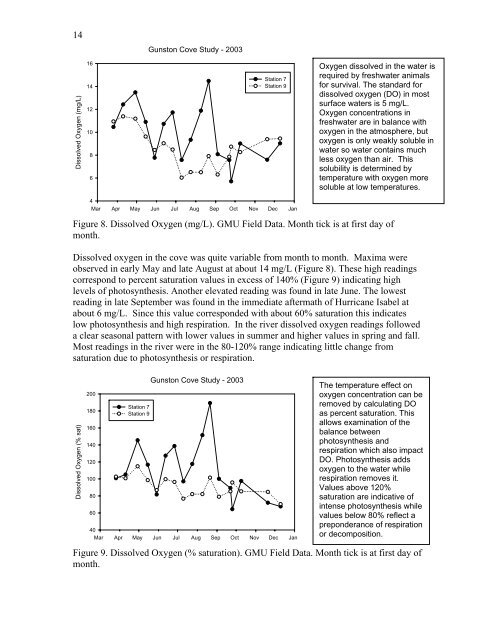NEW: Annual Report - George Mason University
NEW: Annual Report - George Mason University
NEW: Annual Report - George Mason University
Create successful ePaper yourself
Turn your PDF publications into a flip-book with our unique Google optimized e-Paper software.
14<br />
Dissolved Oxygen (mg/L)<br />
16<br />
14<br />
12<br />
10<br />
8<br />
6<br />
Gunston Cove Study - 2003<br />
Station 7<br />
Station 9<br />
4<br />
Mar Apr May Jun Jul Aug Sep Oct Nov Dec Jan<br />
Oxygen dissolved in the water is<br />
required by freshwater animals<br />
for survival. The standard for<br />
dissolved oxygen (DO) in most<br />
surface waters is 5 mg/L.<br />
Oxygen concentrations in<br />
freshwater are in balance with<br />
oxygen in the atmosphere, but<br />
oxygen is only weakly soluble in<br />
water so water contains much<br />
less oxygen than air. This<br />
solubility is determined by<br />
temperature with oxygen more<br />
soluble at low temperatures.<br />
Figure 8. Dissolved Oxygen (mg/L). GMU Field Data. Month tick is at first day of<br />
month.<br />
Dissolved oxygen in the cove was quite variable from month to month. Maxima were<br />
observed in early May and late August at about 14 mg/L (Figure 8). These high readings<br />
correspond to percent saturation values in excess of 140% (Figure 9) indicating high<br />
levels of photosynthesis. Another elevated reading was found in late June. The lowest<br />
reading in late September was found in the immediate aftermath of Hurricane Isabel at<br />
about 6 mg/L. Since this value corresponded with about 60% saturation this indicates<br />
low photosynthesis and high respiration. In the river dissolved oxygen readings followed<br />
a clear seasonal pattern with lower values in summer and higher values in spring and fall.<br />
Most readings in the river were in the 80-120% range indicating little change from<br />
saturation due to photosynthesis or respiration.<br />
Dissolved Oxygen (% sat)<br />
200<br />
180<br />
160<br />
140<br />
120<br />
100<br />
80<br />
60<br />
Station 7<br />
Station 9<br />
Gunston Cove Study - 2003<br />
40<br />
Mar Apr May Jun Jul Aug Sep Oct Nov Dec Jan<br />
The temperature effect on<br />
oxygen concentration can be<br />
removed by calculating DO<br />
as percent saturation. This<br />
allows examination of the<br />
balance between<br />
photosynthesis and<br />
respiration which also impact<br />
DO. Photosynthesis adds<br />
oxygen to the water while<br />
respiration removes it.<br />
Values above 120%<br />
saturation are indicative of<br />
intense photosynthesis while<br />
values below 80% reflect a<br />
preponderance of respiration<br />
or decomposition.<br />
Figure 9. Dissolved Oxygen (% saturation). GMU Field Data. Month tick is at first day of<br />
month.
















